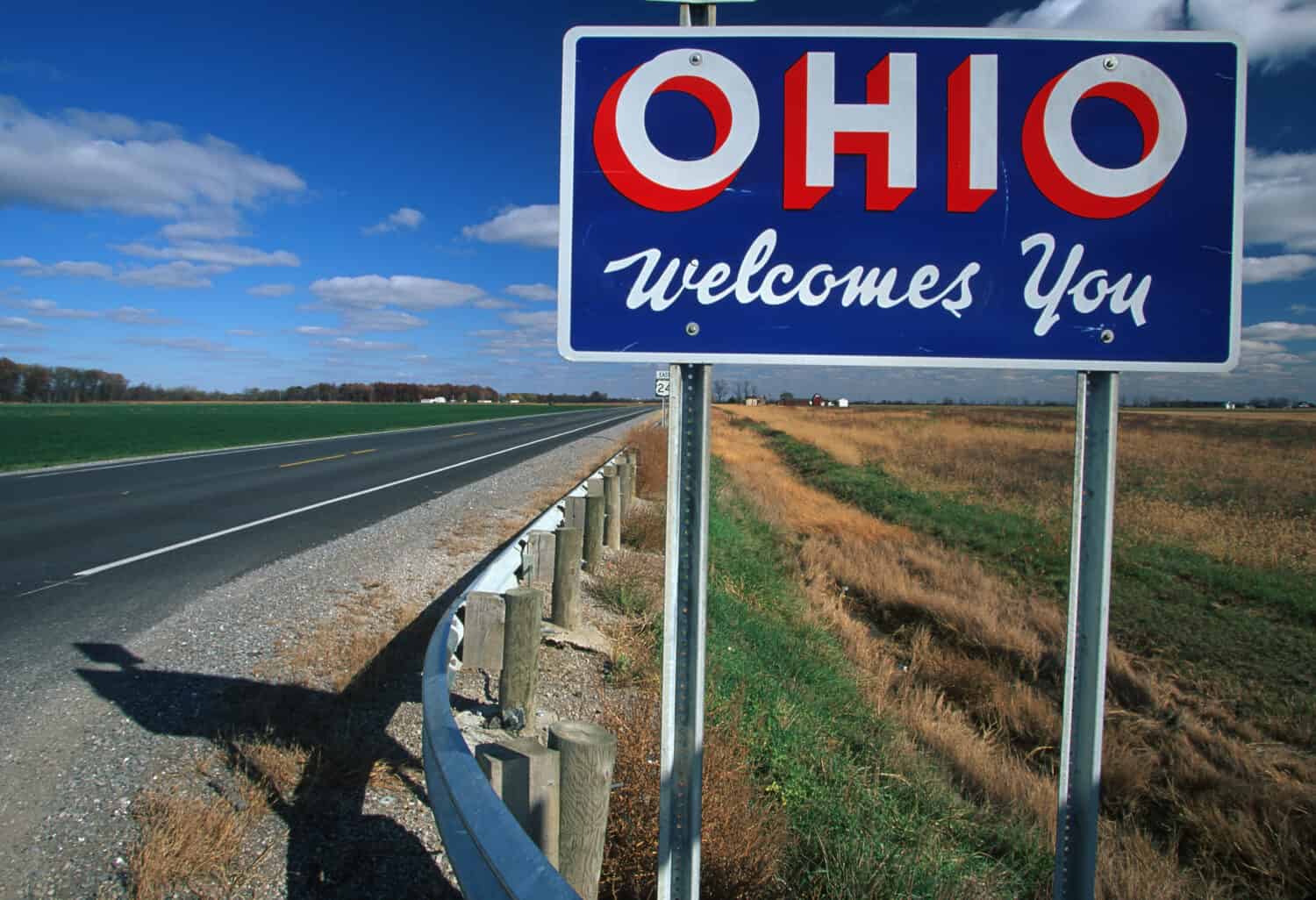Gorgeous blooming flowers fill gardens with amazing color, scent, and movement, but most importantly, they provide food sources for our precious pollinators. Even one or two plants can make a big difference to biodiversity in your yard, but what will grow there? This article takes a look at the best flowers to plant in Ohio and offers top care and planting tips.
Ohio’s Growing Zones
Ohio is a diverse state with two USDA Hardiness Zones: zones 5 and 6. If you’re not familiar with these, it’s the standard that indicates what plants will thrive in your location. It’s based on the average annual extreme minimum temperature. Match your zone with zones indicated on a plant label; they have the most chance of surviving.
The good news is that zones 5 and 6 suit lots of blooming flowers, so Ohio’s gardeners can make a color splash and feed its vital pollinators.
Here are 19 of the best flowers to plant in Ohio for gorgeous blooms.
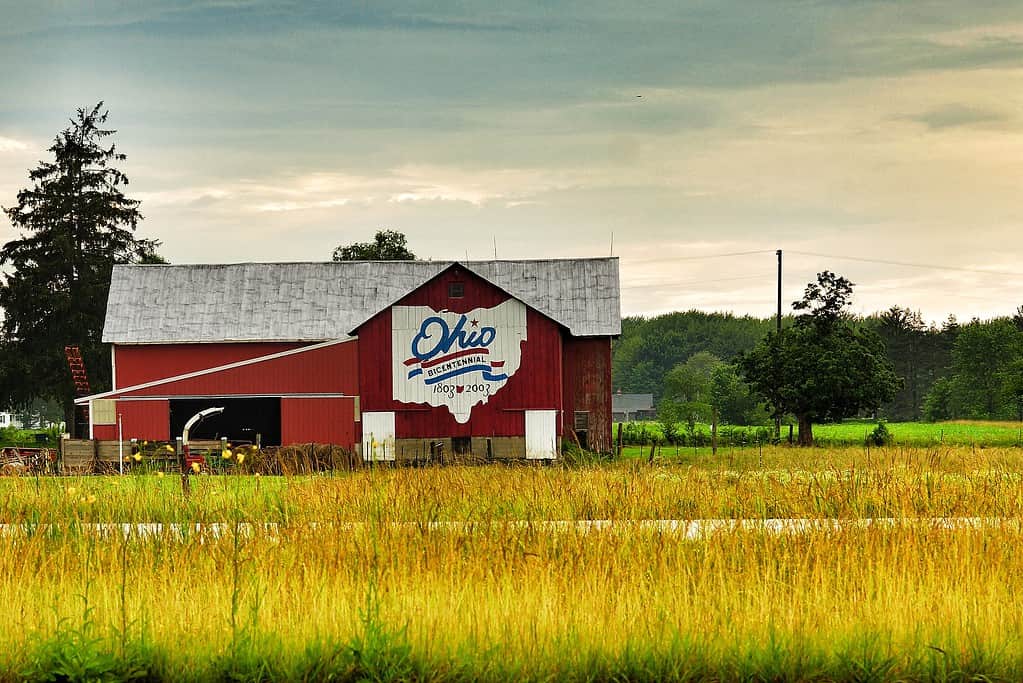
Ohio’s USDA growing zones are zones 5 to 6.
©Photograph by Jason Miklacic; barn painted by Scott Hagan / CC BY-SA 2.0 – Original / License
1. Asters
Glorious two-foot-tall asters come in a variety of blue, purple, white, and pink shades. They suit both flower beds and containers in full sun to partial shade if they’re well drained.
Asters bling up an Ohio fall yard because they tend to flower later in the season compared to summertime plants. This means pollinators can find nectar when the temperatures begin to drop.
Asters love the full sun, and their small star-shaped flowers open wide like stars, hence their “astral” name. Plant them in early summer and keep them blooming by dead-heading regularly and applying organic fertilizer. At least every other day, containerized asters need lots of water to keep those star-struck flowers in full bloom.
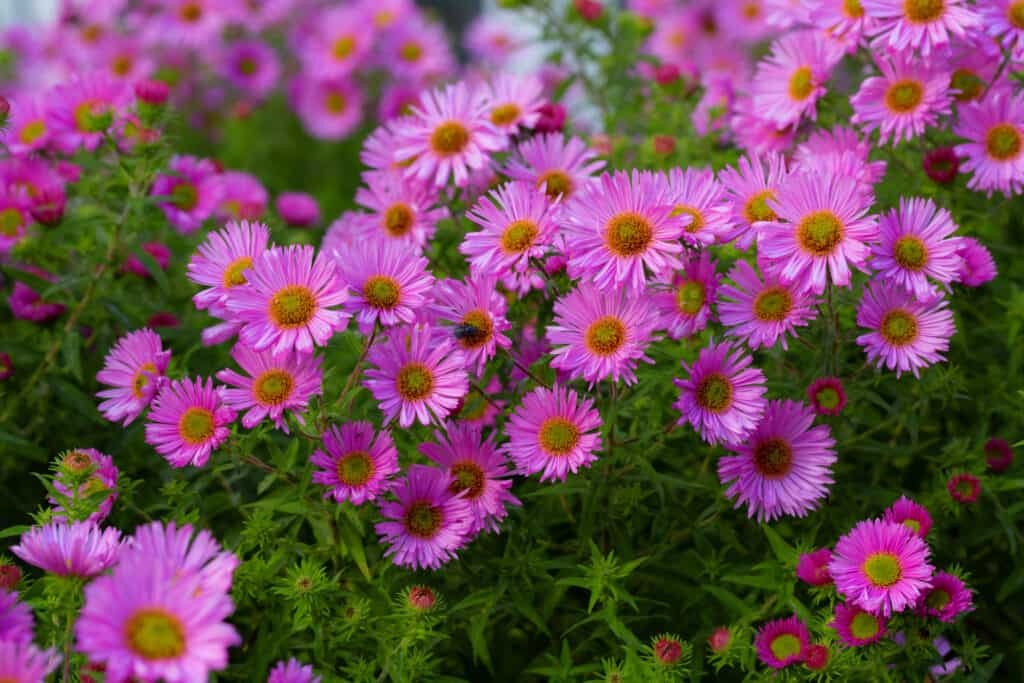
Asters produce lots of late nectar for pollinators during fall.
©iStock.com/Inna Giliarova
2. Blue Vervain
Beautiful blue vervain needs a damp spot, so it’s perfect for pond edges. Once settled into moist soil, it requires barely any care, so it’s perfect for time-pressed Ohio gardeners.
Tall four to six-foot-tall thin blue stems rise from architectural foliage in mid-summer to early fall, so plant them out in early spring when the frosts have passed. Pollinators and birds love them, and their delicate appearance belies their super-tough nature. Traditionally, medical folks used blue vervain to treat coughs and colds.
Choose a damp spot with plenty of sun, and blue vervain will thrive with little assistance, even when the temperature rises.
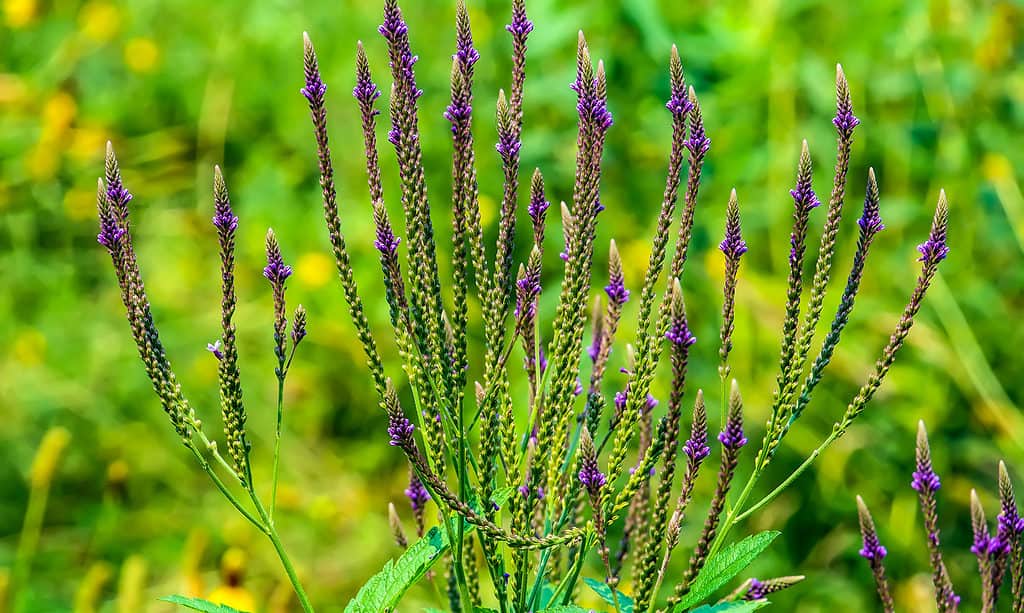
Blue vervain prefers damp soil, so it’s a good choice for pond sides.
©iStock.com/williamhc
3. Azalea
Tropical-looking azaleas landscape an Ohio yard with bright pink, yellow, red, or white blooms during May and June.
This fairly large evergreen shrub requires border space to spread out, around 4-5 feet, depending on the species. They’ll also sit pretty in a large container to brighten up a boring deck, balcony, or patio.
Azaleas need acidic soil. In alkaline or neutral soil, their leaves turn yellow, and they just can’t flower. This is called chlorosis. You can fix it by adding lots of acidic bracken or pine-based mulch to its roots and feeding it with an azalea-specific fertilizer. Container-based azaleas need ericaceous soil and weekly azalea fertilizer.
For the best blooms, choose a sheltered spot with plenty of sunshine.
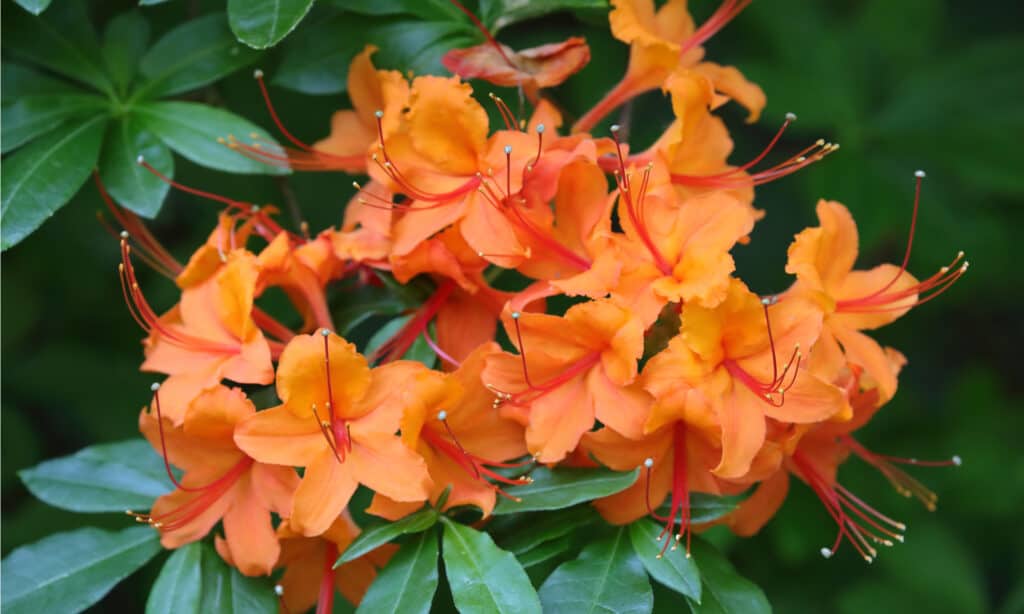
Azaleas require acidic soil to avoid chlorosis. In a container, use ericaceous compost.
©Ole Schoener/Shutterstock.com
4. Purple Coneflower
Native drought-tolerant purple coneflowers brighten Ohio’s yards from a whopping June to October! Each pinky-purple daisy-like bloom reaches 2-5 feet, and rough foliage covers the soil below, trapping moisture and preventing weed buildup.
They’re an important perennial nectar source for pollinators, but they’re so bright and beautiful that gardeners love them too. Native flowers always grow well, so if you pop coneflowers in a flower bed or a container with full sun to partial shade and water them when the soil starts to dry, they’ll thrive for months.
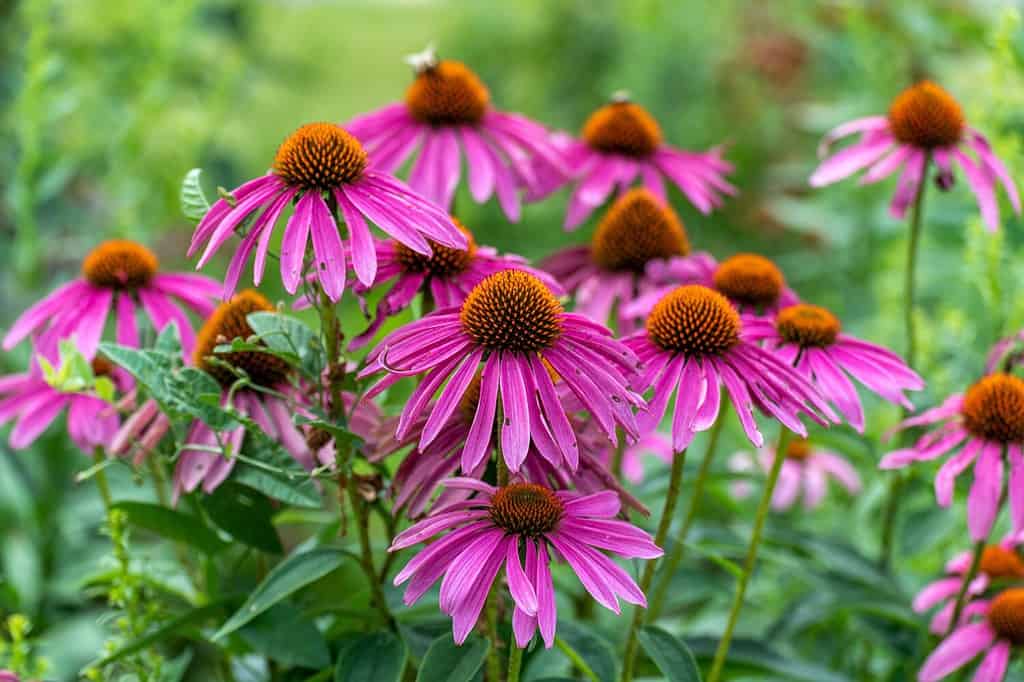
Purple coneflower attractors bees, butterflies, hoverflies and other essential pollinators.
©Barbara Smits/Shutterstock.com
5. Wild Bergamot
Another native purple flower, but a vastly different flowerhead, is the two to four-feet-tall perennial wild bergamot. These lovely lavender flowers bloom from July to September in Ohio and attract jeweled hummingbirds by the dozen.
Wild bergamot likes full sun and average-to-dry soil. They’re fairly drought-tolerant and provide low-maintenance color in mixed flower borders, raised beds, and deck containers. Native Americans used wild bergamot to soothe lacerations, headaches, and indigestion. Because it’s native to most of North America, this epic flower has supported humans for thousands of years.
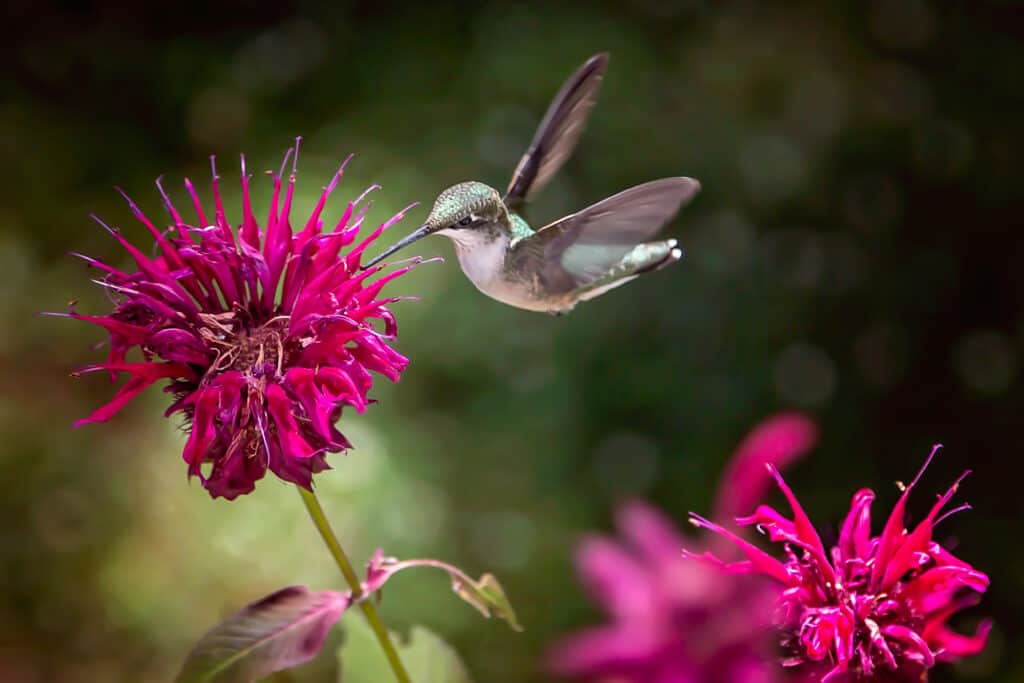
Hummingbirds love wild bergamot’s easily accessed nectar.
©iStock.com/Cavan Images
6. Baby’s Breath
This pretty annual is so easy to grow, it’ll sprout on a sunny windowsill and bloom from late spring right through to fall.
Baby’s breath is a white, pink, or blue plant with tiny delicate blooms. You might recognize them from bridal bouquets. Despite its delicate look, this little flower is tough as they come. It tolerates full sun but prefers partial shade and doesn’t need much fertilizer.
In a flower border with plenty of rotted organic matter, it won’t need extra fertilizer, but a container-bound baby’s breath benefits from fortnightly food and plenty of water.
In Ohio, young plants can hit the soil as soon as the frosts have gone.

Baby’s breath grown in a flower border needs very little fertilizer.
©iStock.com/liuyushan
7. Milkweed
Native milkweed is essential for monarch butterflies because it’s the only plant they lay eggs on. Ohio has 13 native milkweed species that grow in wetlands or prairies depending on the species, so it is a versatile plant, and you should choose one to suit your soil. Wetland milkweed suits pond-side spaces, but prairie milkweed is more suited to a border or container.
Milkweed reaches five feet tall and blooms from June to August in various colors, from vivid orange to pretty pale pink. Ohio’s gardeners should plant it in full sun to partial shade. It’s drought-tolerant and survives heat waves, but container-bound milkweed needs regular water.
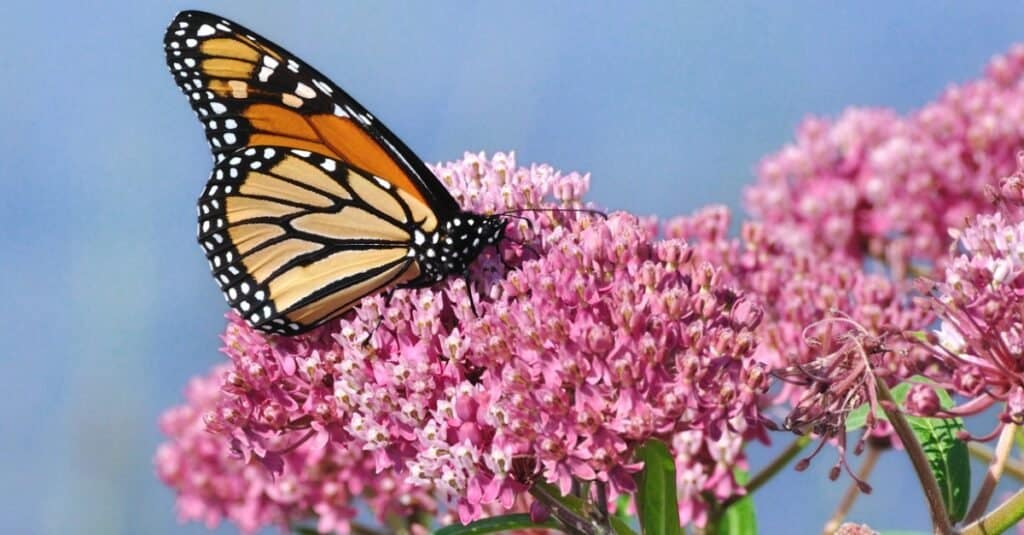
Milkweed is the only flower that monarch caterpillars use to lay their eggs.
©iStock.com/herreid
8. Begonia
Begonia plants grow best in a shady Ohio yard because full sun burns their thick petals. They’re excellent at brightening up a low-light level corner like a porch or north-facing border.
These beauties hail from tropical zones, and they grow from bulbs each year in Ohio. Thick dark green leaves emerge first, followed by fleshy-leaved flowers ranging from white right through to dark pink, purple, red, yellow, and orange in mid-summer. Begonias need plenty of water to keep their flowers blooming.
Pollinators love their nectar-rich flowers, and you can eat them too! Begonia flowers taste citrusy and bling up a boring salad.
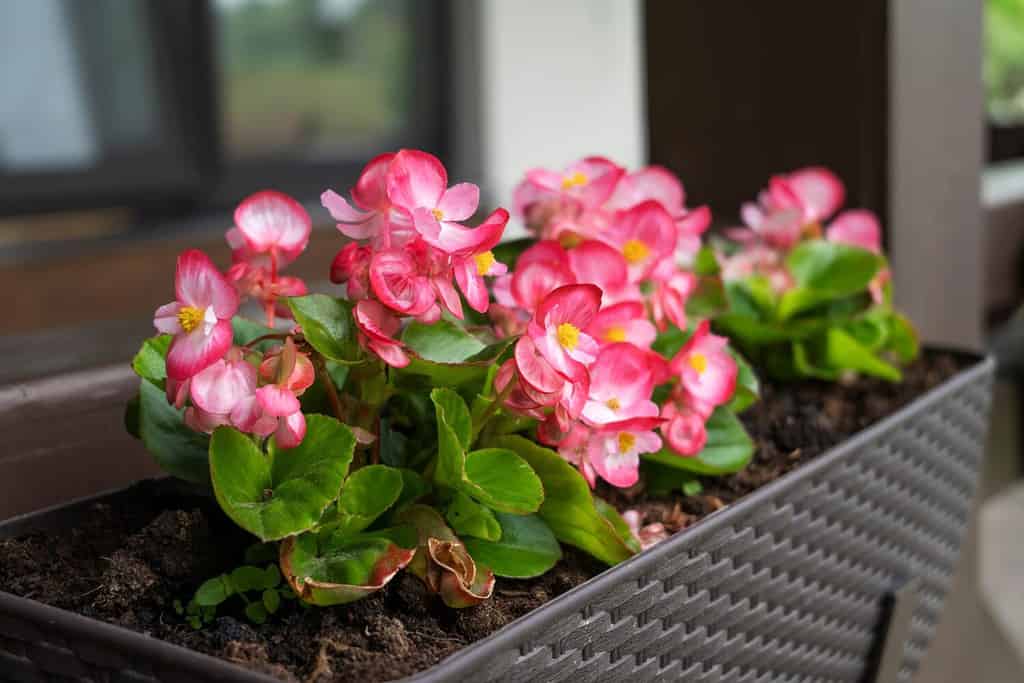
Begonias like a shady spot. Full sun scorches their fleshy leaves.
©IRINA CHETVERIKOVA/Shutterstock.com
9. Celosia
Flame-like fluffy celosia is a unique flower that children and pollinators love. They’re available in a range of colors from white to dark shades and everything in between. Depending on the species, celosia grow from just a few inches to several feet tall.
In Ohio, celosia is annual. These African and Asian natives love heat, so a sunny spot is best, and although they can cope with some drought, well-watered celosia keeps their blooms for longer. Container displays need plenty of water and fertilizer to keep the flowers coming. Deadhead when the spires turn brown and new ones soon emerge. Ohio’s celosia begins to bloom in early summer.
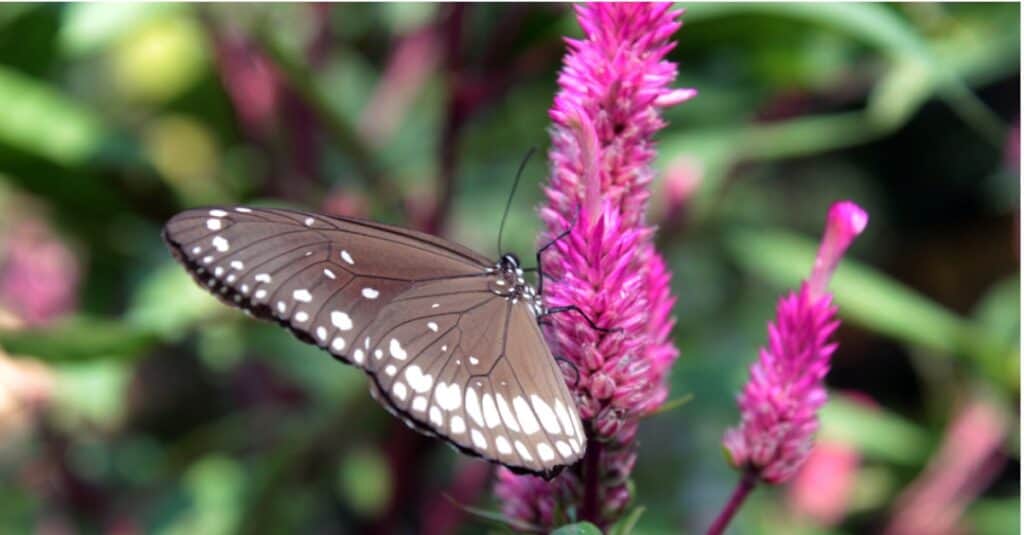
Butterflies love the rich nectar that fluffy celosia flowerheads produce.
©iStock.com/MANORANJAN MISHRA
10. Cosmos
Annual cosmos is a common sight in Ohio yards from early summer to fall.
Daisy-like cosmos reaches a foot to several feet tall, depending on the species, and ranges from pure white to deep red and yellow. Their frilly blooms attract all sorts of pollinators.
These elegant beauties suit the back of a border where their slender stems wave in the breeze. Mexican native cosmos grow best in full sun to partial shade, and they don’t need a lot of water. If yours looks leggy, cut it down to the first pair of leaves. This’ll make it bush out to create a healthier plant, albeit one that flowers a bit later on.

Cutting back colorful cosmos in spring creates a bushier, healthier plant in late summer.
©iStock.com/Passakorn_14
11. Ox-eye Sunflower
Five-foot-tall ox-eye sunflower is instantly recognizable and much loved by children, not least because it attracts gorgeous butterflies. It blooms pretty daisy-like yellow flowers in spring and keeps going throughout summer if it’s regularly dead-headed
Because it reaches such heights, an ox-eye sunflower suits the back of a border. It’s a short-lived perennial that’ll come back for a few years, but it tends to self-seed well, so you may find free plants in various places!
This North American native plant is drought tolerant and a good choice for rocky, sandy, or generally poor Ohio soils. Choose a sunny spot once the frosts have passed, water it until it’s established, and it’ll flower all summer.
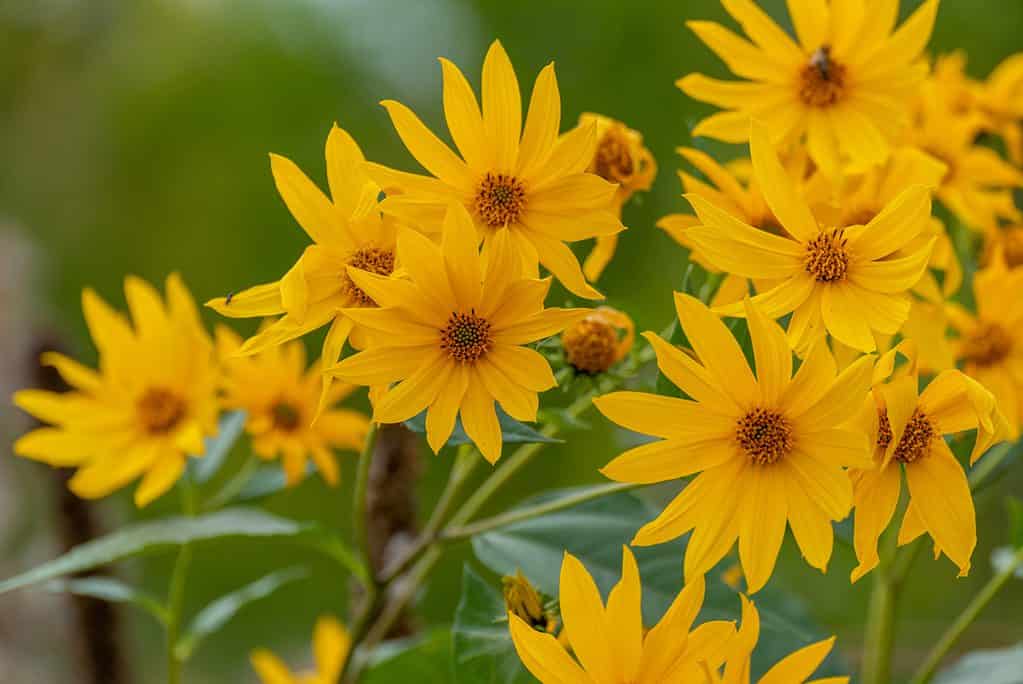
Ox-eye sunflowers are drought tolerant and attractive to pollinators.
©Barbara Smits/Shutterstock.com
12. Dahlia
Charming 2 to 4-foot-tall dahlias grow as annuals in Ohio’s USDA 5-6 zones because they’re native to hot Mexico, Central America, and Colombia. They prefer full sun but will cope with a little shade.
Dahlias grow from tubers, so in Ohio, it’s best to dig them up and store them in a cool, dry place over winter to prevent rot. They can go back outside again in early spring once the frosts have passed and the soil is starting to warm.
Drought-tolerant dahlias deal with heatwaves, and despite their fancy blooms, they’re a cinch to grow. Water them until established, deadhead the old blooms, and let them illuminate the yard.
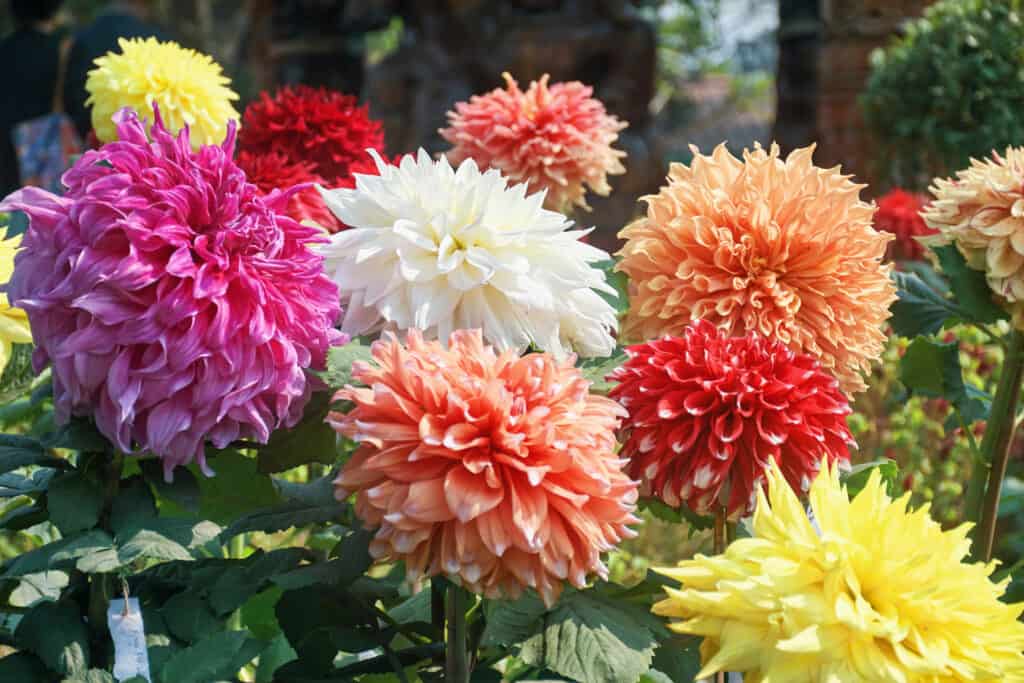
Dig up dahlia tubers in fall to prevent over-winter rot. Plant them outside again the following spring.
©suprabhat/Shutterstock.com
13. Blue False Indigo
Blue false indigo is a five-foot-tall perennial herb with a strong horizontal root system. In its native Ohio, it’s drought tolerant and more than capable of dealing with a heatwave. This summer flowering pollinator magnet bears purple flowers on 12-inch-long erect racemes.
After its purple blooms finish, you can either deadhead or let them develop into long black seed pods. The unusual pods create a stunning display alongside its blue-green foliage. This native herb is a sun lover but copes with a little shade in a flower border or a container.
It’s endangered in the wild, so always buy blue false indigo from a reputable nursery to avoid supporting plant poachers.
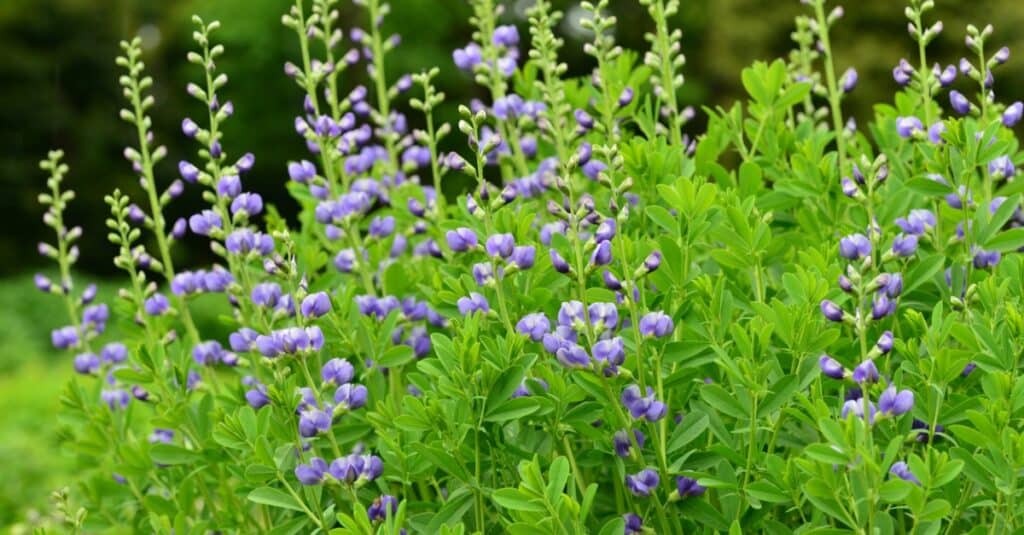
Blue false indigo is endanered in the wild due to habitat erosion and plant poaching.
©iStock.com/magicflute002
14. Large Flowered Trillium
Perennial large-flowered trillium is an Ohio native with wow appeal. Its 20-inch whorl of three white leaves is a yard show stopper during April and early May. It’s such a stunner that in 1986, it was crowned Ohio’s state wildflower.
Trillium grows from a deep underground rhizome which throws up thick fleshy stems. It flowers in mid-spring, sets seeds, then dies back in mid-summer. It’s an excellent early nectar source for pollinators. This woodland plant needs an early morning sun to stimulate its rhizome but can’t cope with the direct midday sun.
Large flowering trillium needs rich organic acidic or neutral soil that’s free-draining because wet soil will rot its rhizome. Choose a spot in your yard that gets morning sun but offers shade at midday and late afternoon. If you’ve alkaline soil, grow large-flowered trillium in a deep container of ericaceous soil placed beneath the existing shrubs.

Large flowering trillium is the official state wildflower of Ohio.
©iStock.com/SHSPhotography
15. Turtlehead
The name gives its appearance away! This easy-care drought-tolerant plant has two-lipped snapdragon-like flowers that resemble a turtle with its mouth partly open (if you squint and imagine it!)
This is one of Ohio’s easiest plants to grow if it’s given rich soil. Come sun or shade, this pretty purple, white, or pink blooming perennial produces two-foot-tall lance-shaped leaves from its clump and blooms all summer. It’s a favorite with pollinators and is suitable for flower beds or containers.
New turtlehead plants need warm, rich soil to get started, so plant yours out after the frosts have passed and the soil is nicely warm. Water it well until you see new growth, and water it regularly through its first season.

Purple turtlehead is drought tolerant, easy to grow, and loved by pollinators.
©Ron Rowan Photography/Shutterstock.com
16. Wild Columbine
The nodding bell-like flowers of wild columbine give it an edge over other blooms. This pretty two-foot-tall yellow-stemmed native produces a mass of pinky-red bells with yellow-red protruding stamens in mid-spring. It’s a favorite with pollinators and vivid hummingbirds.
One of the wild columbine’s best aspects is its movement. Yes, the colors are attractive, but when the bells sway in the breeze, it’s magical. To keep the blooms coming, deadhead the spent flowers regularly.
Wild columbine is a woodland plant, so it likes consistently moist soil. It’s best planted in part shade or near a pond. Part shady yards in Ohio will find beautiful wild columbine self-seeds everywhere. You can’t beat free plants.
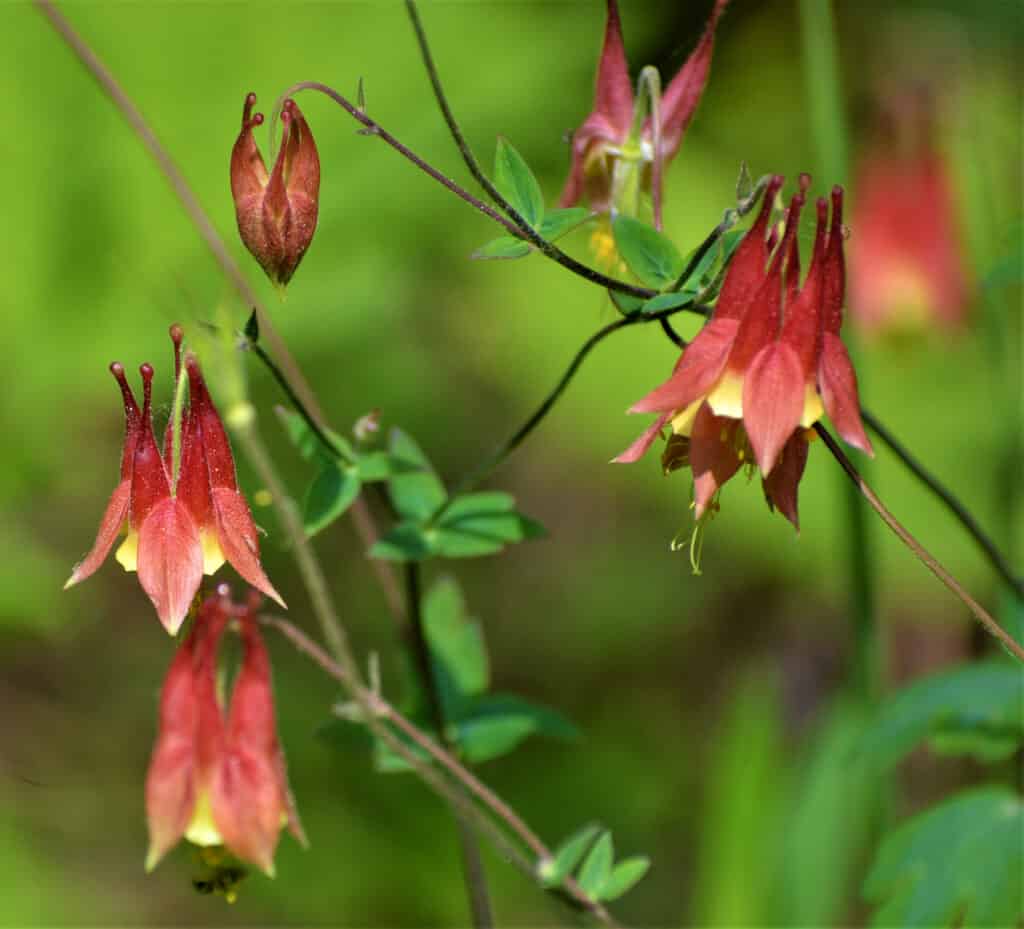
Beautiful columbine is a woodland plant that prefers consistently moist soil and part shade.
©akslocum/Shutterstock.com
17. Impatiens
Ohio gardeners working with shade love impatiens. These bright effortless plants thrive in part-shaded locations and cope well with not only drought but light frosts too. They grow best when they’re planted outside in spring and given lots of water for consistent flowers.
In hot zones, impatiens are perennials that flower year-round, but in Ohio, they’re usually treated as annuals because winter temperatures fall too low.
Impatiens brighten mid-spring to late fall gardens with pink, white, purple, and coral shades. They’ll reach several feet tall and attract pollinators to flower beds and containers.
Impatiens don’t cope well with drought, but they don’t need deadheading to look their best.
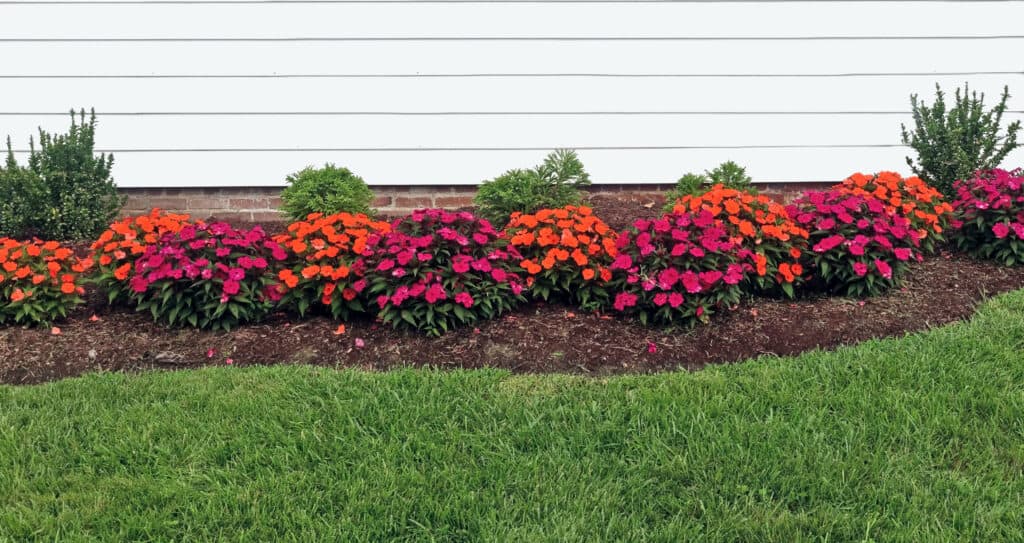
Impatiens brighten up a dark corner because they prefer a shady aspect.
©iStock.com/Joe_Potato
18. Cardinal Flower
Late summer blooming cardinal flower gives Ohio’s yards a much-needed boost of color as fall arrives. It prefers moist soil and full sun or partial shade. When it receives this gold-standard treatment, it’ll shoot up to four feet tall and produce the most glorious flame-red flowers.
The perennial cardinal flower is native to North, South, and Central America’s streams, swamps, and damp woodland. It is a clump-forming stunner with lance-shaped dark green leaves.
Its vibrant tubular flowers bloom on spikes and attract all the bees to the yard. Plant yours outside when the frosts have passed, and the soil is warm. Keep it watered, and those fiery red spikes start to emerge in late July.

Cardinal flowers bloom in fall and provide nectar when there’s not much around for pollinators.
©iStock.com/laroy lindsey
19. Meadow Rose
The best flowers to plant in Ohio for gorgeous blooms wouldn’t be complete without a rose.
Rosa blanda is Ohio’s native wild rose that grows on prairies, meadows, and open woodlands. It’s a glorious sight in a yard with its elegant, arching branches and very few thorns.
Meadow rose is deciduous, so it loses foliage over winter, but it grows back in early spring before smothering its branches with pink five-petalled yellowed-stamened blooms. Needless to say, Ohio’s pollinators love these easy-to-access native flowers just as much as gardeners.
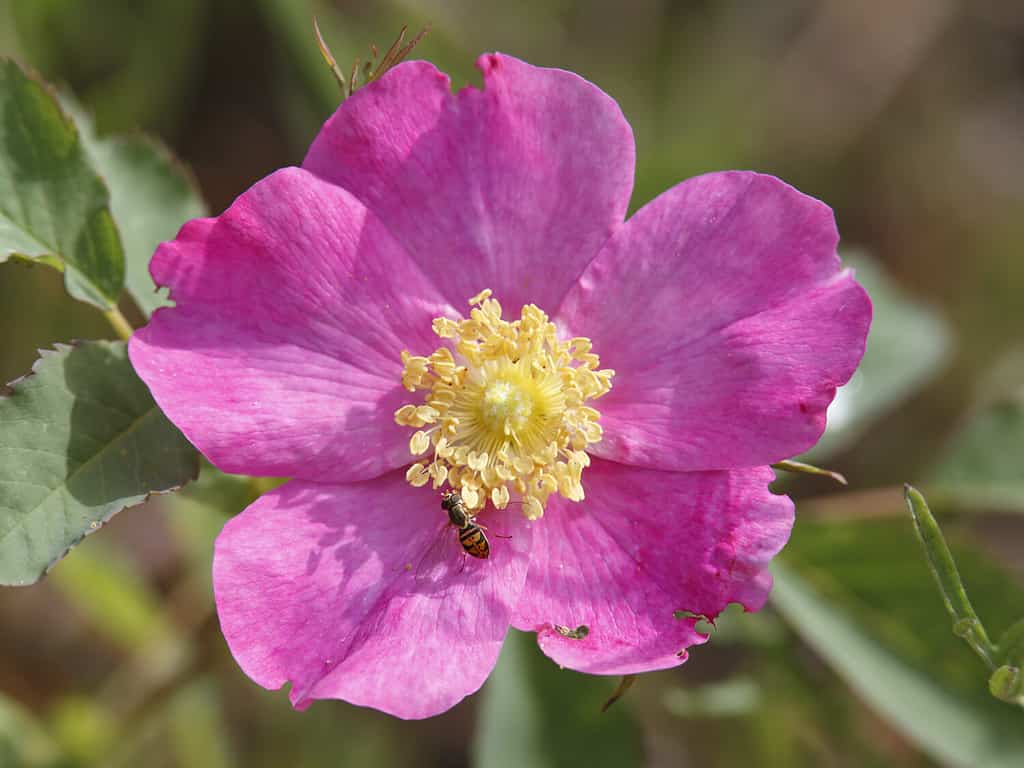
Wild meadow rose has few thorns on it’s long arching stems.
©Brian Lasenby/Shutterstock.com
Thank you for reading! Have some feedback for us? Contact the AZ Animals editorial team.

